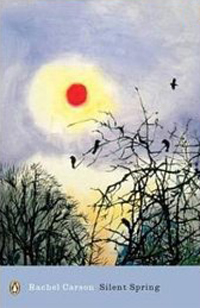A Who’s Who of pesticides is of concern to us all
 Silent Spring
Silent Spring
by Rachel Carson
This is a book that changed the world and brought hideous criticism on its author, and I’m loath to add to or ratify any of that criticism but this book took me six weeks to read and honestly it often felt like a slog. And yet I still think Carson was a good writer, or capable of good writing.
For those who don’t know the book, this now-legendary tract is a polemic against the widespread of use of pesticides such as DDT, on the grounds that they are dangerous poisons that kill far more than the target insects or fungi. Carson gathered together evidence that the supposedly safe pesticides that were widely sprayed from aeroplanes onto thousands of acres of land were killing fish, birds, pets, livestock, even people. A lot of this evidence came from scientific journals, so it’s not as though the problem was unheard of before she got interested, but she brought it to a wider audience and as a direct result, President Kennedy ordered an investigation into pesticide misuse.
“A Who’s Who of pesticides is therefore of concern to us all. If we are going to live so intimately with these chemicals – eating and drinking them, taking them into the very marrow of our bones – we had better know something about their nature and their power.”
With my long history of interest in environmental issues, I am curious why this book didn’t engage me. I think there are several reasons, but they should be cast against the plain fact that this book was a bestseller and has remained in print for decades – obviously others had a better experience than me!
To begin with, I found the tone very uneven. The book starts with a long emotive intro completely devoid of facts, then launches into super technical explanations. This pattern continues, though the balance overall tends to be of more technical language interspersed with poetic sections. The references are all hidden at the back of the book so it’s near impossible to tell what’s scientific fact and what’s speculation in some places – but then elsewhere it’s perfectly clear so obviously Carson was capable of achieving that balance.
“In Greek mythology the sorceress Medea, enraged at being supplanted by a rival for the affections of her husband Jason, presented the new bride with a robe possessing magic properties. The wearer of the robe immediately suffered a violent death. This death-by-indirection now finds its counterpart in what are known as ‘systemic insecticides’. These are chemicals with extraordinary properties which are used to convert plants or animals into a sort of Medea’s robe by making them actually poisonous.”
Another issue I had was that, although we still face many similar problems, the specifics are different. I struggled with the current-day relevance of the endless facts and found myself wishing for an up-to-date equivalent. Of course, the difference is that these days that information is available to me if I go looking for it (in fact a quick scan of the petitions I’ve signed on Change.org is a good start).
On the other hand, this book also had the presumably desired effect of making me furious at the ignorance and deliberate misinformation that led to Carson writing this book – partly because I know that governments continue to side with big business against scientific advice, even when the advice is a cautious “let us do a couple of tests”.
“Soil is in part a creation of life, born of a marvellous interaction of life and non-life long aeons ago. The parent materials were gathered together as volcanoes poured them out in fiery streams, as waters running over the bare rocks of the continents wore away even the hardest granite, and as the chisels of frost and ice split and shattered the rocks. Then living things began to work their creative magic and little by little these inert materials become soil.”
Overall, I’m glad I’ve read it but can’t say it holds a candle to more recent examples of popular science – the science itself is explained clearly but isn’t made interesting and isn’t presented in a logical order (to my mind) and varied wildly in how engaging it was. Clearly this was an early example of a genre that has since been refined and practised much more.
Sections of this book were first published as a series of articles in the New Yorker.
First published 1962 by Houghton Mifflin.
Source: Borrowed from the library.
Challenges: This counts towards the 2014 Popular-Science Reading Challenge.
It’s likely good you got through it. Although I definitely admire Rachel Carson and what she did, I dont think I’m on a path to read her book. But so glad more people are environmentally conscious these days. I’m sure we need more like her. Cheers